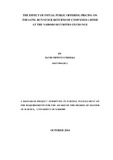| dc.description.abstract | The phenomenon of IPO pricing has long existed in the global stock market, although the magnitude of under pricing varies from country to country. Several academic researchers found in their studies that IPOs show underperformance in the long-run or have negative abnormal returns over holding periods after the IPO issue date. There is not sufficient evidence yet in the literature to conclude that the IPO pricing decisions is the main explanatory factor for the long-run performance of firms. The objective of this study was to investigate the effect of IPO pricing on the long run stock returns of companies listed at Nairobi Securities Exchange (NSE), Kenya. This study used descriptive research design. The target population of this study was all firms listed at the NSE in Kenya. From the listed companies in NSE, the researcher studied all the firms that have issued IPO from 2000-2013. This study used secondary data collected from the NSE, the Capital Market Authority (CMA), annual reports of the firms, and other research material on share prices. The data was analyzed using descriptive analysis and inferential analysis technique. Statistical Package for Social Services (SPSS) software aided in data analysis. Further, the study used multivariate regression was be used to test the influence of the explanatory variables on the long-run performance, measured by market adjusted buy –and hold abnormal (BHAR).
From the regression analysis, the study revealed that 51.5% of the variation in long run performance of shares was explained jointly by 1st Day pricing differential between the offer price and closing day one price, age in years of firm is the difference the between the offer firm‟s IPO year and the founding year, size of the firm as measured by total assets, number of shares issued and the percentage subscription as the obtained coefficient of determination (R2) from the model summary was 0.515. The study further revealed that the regression model predicting the relationship between the long run performance of shares and independent variables was significant. The study deduces that holding all the other factors constant, long run performance of shares would be 8.736. A unit change in the difference between offer price and closing day one price holding the other factors constant would lead to change in long run performance of shares by 0.068. For the case of firm age, Size of the firm, number of shares issued, and percentage, the effect they had on long run performance of shares was -0.371, 7.147*10-8, -1.524*10-9 and 0.008 respectively.. The firms should put good strategic measures in place to ensure continued performance of their shares in the long run. These findings have implications for market regulators, company management and investors. | en_US |

